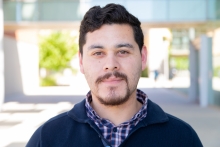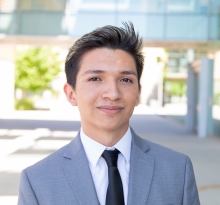Diana Cruz Garcia
Diana Cruz Garcia is an uprising third year undergraduate student from Los Angeles, CA. Expected to graduate in Spring 2021 with a BS in Bioengineering, Diana has already begun to make her mark at the University of California, Merced by conducting research and being an active member in her community. As a brother in UC Merced’s professional engineering fraternity Theta Tau, Diana enjoys inspiring other brothers as well as her peers in developing themselves professionally. She aspires to grow as a leader in her academic career and also as an influencer in her YouTube career. Diana hopes to change gears with her content and start a Women In STEM series in order to teach and guide younger audiences to the field of STEM and higher education. Aside from youtube, Diana finds herself the happiest with her family, shopping, taking pictures, and simply sipping on Jasmine Green Tea Boba while watching her favorite Netflix series. In the future, Diana plans on getting her PhD in biomedical engineering, continue her research in artificial organs and cancer, and hopefully make a new discovery in works to find a cure for cancer. Overall, Diana wants to become a Latina in STEM that younger generations can look up to and follow.
3-D Vessel Formation by Stem Cell Co-Differentiation
Diana Cruz Garcia, Jose Zamora, and Kara E. McCloskey, PhD; School of Engineering, University of California, Merced
As the fields of tissue engineering and drug discovery transition towards using larger organoids, they are limited by integration with perfusable blood vessels. Thus, the need for developing perfusable vascular is mounting. Using a polydimethylsiloxane (PDMS) microfluidic devices, perfusable blood vessels have been generated by seeding human aortic endothelial cells (HUVECS) and normal human lung fibroblasts (NHLFs) within fibrin or collagen gels, however, these vessels do not integrate with other cells/tissues. This study examined the ability to co-differentiate both endothelial cells (ECs) and smooth muscle cells (SMCs) from a population of mouse embryonic stem cells (ESC)-derived vascular progenitor cells (VPCs) within our 3D microfluidic device. Using our two-step serum free induction protocol for EC derivation, we have explored different matrix combinations (fibrin, fibronectin, collagen I& IV) that co-direct VPCs into neo-vessel structures. This research explores the co-differentiation of multiple tissues that can later be incorporate in the development of larger organoids.
Alexander Del Toro
Alexander Edward Del Toro is a third year transfer student from Oakland, Ca. He is majoring in Cognitive Science and is expecting to graduate in Spring 2021. This is Alexander’s first semester on campus but has hit the ground running since his arrival. He works part time at UC Merced’s ILL library department, is an active scholar for the transferring, returning, and veterans programs (TRV), a program fellow for the strengthening talents and exploring pathways (STEP) program, and currently a scholar for the UC LEADS program. Alexander is eager to help his fellow colleagues. He hopes to one day advocate for marginalized students to continue onto graduate programs and diversify the landscape of academia. Alexander has his eyes set on earning a PhD in either neuroscience or neurobiology, but is still exploring his options for graduate school. After his studies, Alexander is looking to educate the next generation of students in Oakland and give back to a community that has allowed him so many opportunities.
Molecular and Cellular Mechanisms Underlying the Transition in the Brain From Acute Ethanol Exposure to Chronic Ethanol Exposure
Alexander E. Del Torro, Pratik Adhikari, and Fred Wolf, PhD; School of Natural Sciences, University of California, Merced
Alcohol is one of the most widely abused drugs, yet the molecular mechanisms involved in simple behavioral adaptations like tolerance, preference, and reward are still not well known. Our goal is to uncover molecular mechanisms for behavioral plasticity that are initiated by the first exposure to ethanol. Individuals nearly always require repeated exposures to ethanol to elicit an alcohol use disorder (AUD). How do the early molecular events relate to AUDs? A current hypothesis is that drug induced changes in gene expression alter the molecular landscape for the next drug exposure: each repeat exposure will act on neurons with changed properties and changed gene expression responses. We identify genes that are regulated by the first ethanol exposure and determine their role in ethanol-induced behavioral plasticity. Ethanol activates the Mef2 transcriptional activator to induce Hr38, and the Sirt1 histone/protein deacetylase terminates Hr38 to promote tolerance. Furthermore, the three genes function in the same neurons, the mushroom body a/b neurons, to promote ethanol tolerance, preference, and reward. Our findings suggest that ethanol uses a rapid and transient regulation of the expression of specific genes to allow a coherent molecular program to drive behavioral plasticity.
Victoria Lerda
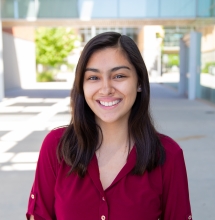 |
Major: Chemical Sciences
Home City: Lincoln, CA
Contact: vlerda@ucmerced.edu
Faculty Mentor: Ben Stokes
|
Victoria Lerda is a rising third year undergraduate student studying chemistry. She grew up Lincoln, CA. She is expected to graduate Spring 2021 with a BS in Chemistry with a Chemical emphasis. As a first generation and undocumented student, she hopes to serve as a role model to her younger family members as well as other undocumented students. Victoria is a founding officer and current Vice President of the Merced Chemistry Club at University of California, Merced. Victoria hopes that by doing research in an organic chemistry lab over the summer and at another UC next summer, she will discover her future career path interests and then she will be pursuing a PhD in Chemical Biology. To unwind, Victoria likes to play video games and spend time with her family.
BrØnsted Acid-Catalyzed Stereospecific Dearomative Spirocyclization of Cis-ß-Meth(hetero)arylstyrenes
Victoria L. Lerda, Anargul Tohti, and Benjamin J. Stokes, PhD; School of Natural Sciences, University of California, Merced
Spiroheterocycles and quaternary geminal dialkyl groups are both important molecular motifs in important synthetic and naturally occurring compounds. There are few direct methods available to install a spirocyclic quaternary center adjacent to a second quaternary center. We hypothesized that a geminal dialkyl carbon atom linking the 3-position of a benzo-fused five-membered heteroarene to the β-position of a styrene would lead to a dearomative Friedel–Crafts-type cyclization in the presence of acid, with the heteroarene serving as the electrophile. Herein, we describe a Brønsted acid-catalyzed stereospecific dearomative spirocyclization of benzothiophenes by pendant cis-configured styrenes linked by a geminal dialkyl carbon atom. The reaction optimization is described in detail and is accompanied by a preliminary reaction scope (specifically yield and regioselectivity outcomes due to substituent variation) and mechanistic discussion.
Sara Perez Vite
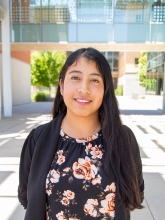 |
Major: Environmental Engineering
Home City: San Jose, CA
Contact: sperezvite@ucmerced.edu
Faculty Mentor: Sarah Kurtz
|
Sara Perez Vite is a fourth-year undergraduate student from San Jose, CA. Expected to graduate in Fall 2020 with a BS in Environmental Engineering, Sara is a transfer student, and she is taking advantage of all the opportunities she has at the University of California, Merced by getting involved in the community and starting research. She is a member and officer of the Solar Energy Association at UC Merced, and Sara hopes to help the community by reducing pollution and helping with climate change. Sara aspires to achieve a Ph.D. in Environmental Engineering because she is interested in renewable energy that can help reduce greenhouse gases around the planet. A long-term goal that Sara has, is to work with other researchers to make a sustainable world, by giving the communities a better future and a better environment.
The Efficiency of a 10-Year-Old External Compound Parabolic Concentrator
Sara Perez Vite, Jonathan Ferry, Sarah Kurtz, PhD; School of Engineering, University of California, Merced
The non-tracking external compound parabolic concentrator (XCPC) is a solar thermal system built at the University of California, Merced in 2009. It was designed to provide thermal energy to a double effect absorption chiller at low capital cost and low energy cost. The XCPC has been running for over 10 years to power different operating systems such as an evaporator and absorption chiller. The expected life span of the system is twenty-five years. Ten years is a good time to do a benchmark of the operating efficiency to see if it changed through the years due to equipment use, weathering, and natural degradation. Data were collected during the summer from the North-South XCPC to calculate the solar power, collector power, and efficiency. The efficiency was calculated under different load conditions with both dirty and clean collectors. The collected data and graphs showed that at low temperature 74 °C the dirty collectors had 57% operating efficiency, while the clean collectors had 62% efficiency. At higher temperature 151 °C, the dirty collectors had an efficiency of 28%, and the clean collectors had 32% operating efficiency. After 10 years, the XCPC providing thermal energy has degraded by 10% in area due to vacuum tubes losses. Even though the collectors were very dirty, the efficiency was not drastically affected by the soiling since the collectors collect direct and diffuse light.
Jasmine Posada
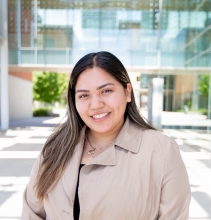 |
Major: Human Biology
Home City: North Hollywood, Los Angeles, CA
Contact: jposada3@ucmerced.edu
Faculty Mentor: Anna Beaudin
|
Jasmine Posada is a passionate, second-year, undergraduate student majoring in Human Biology along with a minor in Anthropology. She is currently part of a Developmental Immunology Lab and hopes to one day become an Immunologist. Her determination and commitment to succeed in academia comes from her parents. She aspires to and acts as a role model for future leaders through mentorship, leadership, and research. Being part of an organization called Global Medical Training, Jasmine was able to travel to Nicaragua and serve medically deprived communities and by going on this trip she noticed almost every patient needed to be prescribed parasite treatment. Clean water in the United States is something we overlook because we have been grateful to be blessed with such resources, but this is not the case with other countries. This boosted Jasmine’s passion for joining a research lab and is specifically working with the parasite Toxoplasma Gondii. She hopes to one day change the world taking one step at a time, being determined, and having fun along the journey.
The Impact of Maternal Infection on Fetal Cytokine Repertoire
Jasmine Posada, April C. Apostol, and Anna E. Beaudin, PhD; School of Natural Sciences, University of California, Merced
In adulthood, hematopoietic stem cells (HSCs) reside in the bone marrow and generate all the blood and immune cell lineages in the body. During infection, inflammatory signals directly influence HSC function, but little is known about how maternal inflammation shapes fetal hematopoiesis. Recent evidence from our lab indicates that a maternal infection evokes expansion of fetal HSCs and impinges on HSC function. We hypothesize that these changes occur as a direct response to alterations in the fetal inflammatory cytokine repertoire. In order to investigate fetal cytokines following maternal infection, we injected pregnant C57BL/6J mice with a low-dose of Polyinosinic:polycytidylic acid (Poly I:C), a viral mimetic. One day following infection, levels of inflammatory cytokines were assessed in fetal liver supernatant and amniotic fluid using a multiplex immunoassay. We observed an upregulation of key cytokines such as IFN-B, IL-27, and IL-1B in the fetus that may have been in response to an induced maternal inflammation. We now aim to build on these results, gain insight into how changes to the fetal environment are influenced by maternal infection, and define the critical mediators that have a lasting impact on immune development and function across the lifespan.
Pedro Valencia Landa
Pedro Valencia Landa is a third year undergraduate student from Sunnyvale, CA. Expected to graduate in Spring 2021 with a BS in Ecology and Evolutionary Biology, Pedro begun to make his legacy at the University of California, Merced by conducting research in stable isotope analysis. As an active member of the bobcat leadership series and a certified bobcat leader, Pedro believes that being an activist is a good way to dedicate his time, and efforts for better reforms of the education system. On his free time, Pedro enjoys photography, and often finds himself visiting natural reserves looking for a new photo to capture. He aspires to achieve a PhD in earth and planetary science, and his ultimate goal is to be able to give back to the underrepresented community by helping the next generation of researchers and doctors accomplish their dreams while bridging the ethnicity gaps currently present in medical fields and higher education.
Does Analyzing Bulk Bone for Organic Carbon and Nitrogen Isotopes Return Similar Results to Analyses of Isolated Collagen?
Pedro Valencia Landa, Robin B. Trayler, PhD, and Sora L. Kim, PhD; School of Natural Sciences, University of California, Merced
Stable Isotopes of carbon and nitrogen from bone collagen are commonly used as indicators of diet and ecology for a variety of modern and fossil mammals. While nitrogen is present only in bone collagen, carbon is present both in the organic (collagen) and inorganic (mineral) phases of bone. Currently, demineralization of bone is both time consuming and may lead to undesirable damage of the extracted collagen, potentially altering isotope compositions. We compared isotope compositions from demineralized and unaltered bone to quantify the effect and necessity of demineralization. We selected samples of bone and dentine from modern gray wolves (Canis lupus) and a modern domestic goat (Capra hircus). An aliquot of each sample was demineralized using 0.1 M HCl. We analyzed the nitrogen and carbon isotope composition of the extracted collagen and the bulk material (bone, dentine) using a Costech Elemental Analyzer. Preliminary results show that demineralization shifted δ13C values significantly lower and did not significantly shift δ15N values. Therefore, we recommend demineralizing bone collagen before analysis of nitrogen and carbon isotopes is made.

